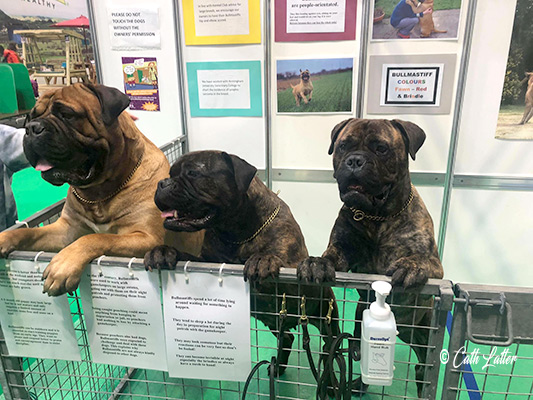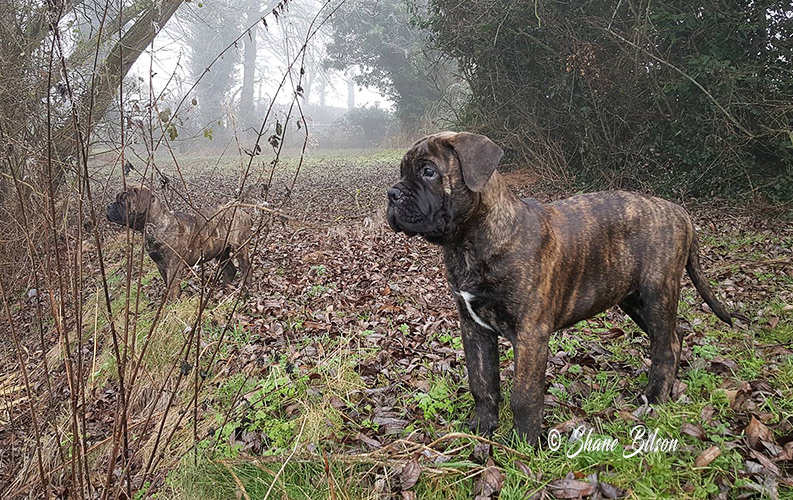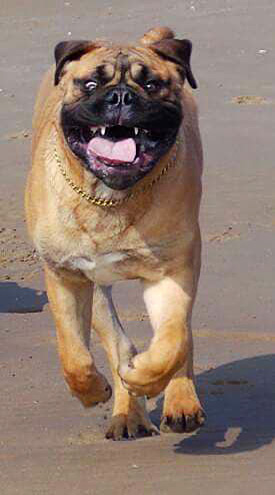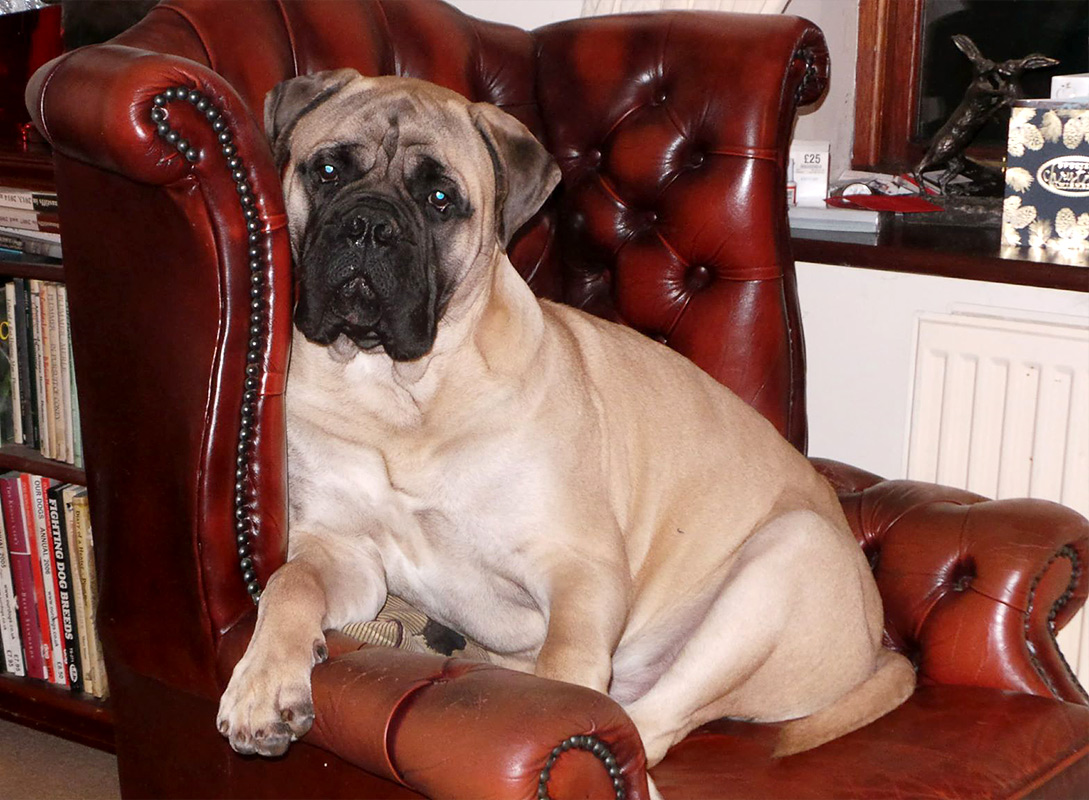ABOUT THE BULLMASTIFF
The Gamekeeper’s Night Dog
This old English breed has in the past been known by the names of “Bull and Mastiff dog” “Gamekeeper’s Night Dog” “Bull-Mastiff” and now “Bullmastiff” Historically classed as a member of the Molosser breeds it has been suggested by some writers on the breed that its origins in one form or another perhaps could go back to pre-Roman times.
The Gamekeeper's Night Dog was developed as a guard dog during the middle of the 18th century when Gamekeepers were looking for the ideal “night dog” to accompany them on their patrols. The Gamekeeper’s duties were dangerous and they needed a powerful agile and faithful dog with all the courage in the world to assist them in their job. The dog’s task was to pursue and bring down a poacher and hold them without savaging until the Gamekeeper arrived.
However the dogs of this era were keener in temperament than what we see and what we would define as acceptable today.
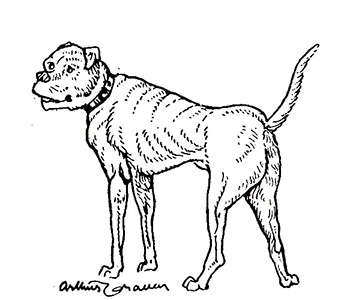
What the original Mastiff Dog may have looked like
Illustration by Arthur Craven - circa 1930
In those days the dogs they had were the Mastiff who was extremely powerful and formidable in appearance, but stable by nature, trustworthy, loyal and brave; and the Bulldog who was sturdy, determined, fuss less, brave and with silent self-reliance. It is said that the Mastiff and the Bulldog are the ancestors of the Bullmastiff and that dogs which were produced from the combining of the Mastiff and Bulldog blood were selectively bred to seemingly provide the perfect dog for the Gamekeeper's requirements. Their favourite colour was brindle because they were so inconspicuous, they did not attract unwanted attention by day or night, and when working, the brindle dog blended into the background.
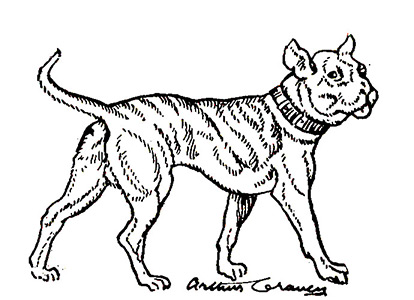
What the earlier Bulldog may have looked like
Illustration by Arthur Craven - circa 1930
It must be remembered that the Mastiffs used were probably smaller than those we see today, and the Bulldog was more “leggier” and lighter in type. The ability to track was also a great advantage, and it is suggested by some that at one stage Bloodhound blood was incorporated in the breeding of these dogs. It is also suggested that numerous other out-crosses may have been used in the early days too.
The size and power of the Mastiff, combined with the speed and agility of the Bulldog produced a dog of forbidding size with a courageous temperament and sufficient athleticism to chase away any intruder. It could be said that they were the “light heavy-weight” of the canine race.
The Gamekeeper's Night Dog was without doubt the enemy of the poacher, and could when desired overpower any human being. He was used to observe and track down any intruder; he was quick in action and this combined with his immense strength and power enabled him to chase and knock a man down with ease. Firearms and other weapons did not hinder him in his work, once he had silently caught up with his surprised foe, he would pin him to the ground and “hold him” there in a vice-like grip.
Night Dogs were said to be able to keep an enemy down for hours, and never relax their vigilance until they had delivered him to their master. Even then they kept a careful watch to see that all was well, and at the least sign of the poacher resisting the Gamekeeper, the dog would again take charge of his man. Without savaging them, the Night Dog tired the poacher out, letting him know that he must go and do exactly as his master bids.
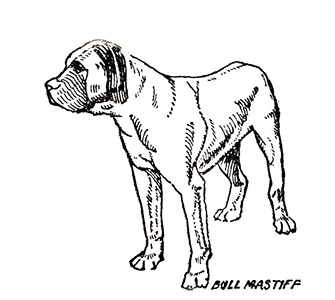
Bull-Mastiff of the 1930s
Illustration by Arthur Craven - circa 1930
The Gamekeeper’s Dog Show
In the year 1900 the first Gamekeepers' Dog Show was run, and it was at this fixture that the "Night-Dog" made its first public appearance, where, in order to bring the breed's qualities more before the public eye, men were invited to “go against the dog”, and the Press and public alike were astounded at the wonderful performances which were put up. The method adopted was to muzzle the dog firmly, and the demonstrating “poacher”, after being well padded up, was given a good start before the dog was sent after him. The animal not only speedily succeeded in reaching his foe, but by hurtling his weight against him, brought him to the ground and held him there until his owner called him off. Never once did a dog fail to carry out the duties which were required of him.
"On Duty"
No dog has ever been bred that excels the Night Dog from a Gamekeeper's point of view, they saved the lives of many Gamekeepers of old, and by their use on estates they were the means of keeping poachers away. Not only was the dog powerful, he was usually a silent worker, and when on duty refrained from giving voice, unless it was to let his master know his exact locality when he has secured his prisoner. The breed, when properly trained, would accompany their keepers and walk at heel, when off the lead they had to be steady to livestock, were trained to ignore game and athletic enough to be able to negotiate all kinds of obstacles, be it going under or clearing fences and gates when in pursuit of an intruder.
At night they would, when required, stand practically as still as statues, and if necessary conceal themselves in a clump of trees; but once given the signal they would quickly emerge, springing into action, they would drop and capture their man, and make sure he did not get away. It would indeed be more than a superman that could free himself from these animals when captured, and even if the enemy was armed it would matter very little; for what use were weapons if one wasn’t given the opportunity to use them? When working at a distance off the lead from their Keeper they had to operate under voice control, had to exercise discretion, perform beyond their training and never act on impulse, in other words--think for themselves.
These “Night Dogs” were the ancestors of today’s Bullmastiffs.
The good qualities of the Night Dog were realised and by the end of the 18th century one was found on almost every estate.
The Bull-Mastiff
The Night Dog became known as the "Bull-Mastiff" on the breed’s permanent fixation of type. One of the breeders of that time "Mr. S. Moseley" owner of the Farcroft kennels, after many previous trial crosses of Bulldog and Mastiff, produced the "Moseley Recipe" helping to standardise breed type.
The Moseley Recipe
"Taking a Mastiff bitch and a Bulldog I produce a 50-50. A bitch of these I mate to a Mastiff dog, and this gives me a 75 per cent Mastiff, 25 per cent Bulldog bitch, which I mate to a 50-50 dog. A bitch from this litter 621/2 Mastiff, 371/2 Bulldog, I mate to a 50-50 dog, and a bitch from this litter I put to a 621/2 Mastiff, 371/2 Bulldog, which gave me approximately my ideal 60 per cent Mastiff 40 per cent Bulldog. I repeat this from other bloodlines as an outcross, and thus I established my Farcroft strain, and the Bull-Mastiff a standard breed of set type, which breeds true - like produces like".Mr. S. Moseley of the Farcroft kennels
Kennel Club Recognition in 1924
In the Show Ring the breed was officially recognised by the UK Kennel Club in 1924, when they announced that Bull-Mastiffs "if pure bred as such" could be entered at dog shows in “Any Other Variety” classes. At this time “type” had been fixed for about a decade. The definition of pure bred being that both parents, and the preceding three generations had been Bull-Mastiffs.
In 1925 breed classes were put on at shows and in 1927 Bull-Mastiffs were added to the non-sporting section of the register of breeds.
It was in 1928 that Challenge Certificates were allocated to the breed.
Tiger Prince (Born 21.06.1925 registered as fawn, owned & bred by Mr. V.J. Smith) won the first Dog Challenge Certificate, and the first Bitch Challenge Certificate was won by the brindle Farcroft Silvo (Born 18.03.1925, owned & bred by Mr. S. E. Moseley).
Farcroft Silvo won Challenge Certificates at the next three consecutive shows in 1928, and so became the breed's first Champion. Farcroft Silvo also held the first record for the most Challenge Certificates won by a brindle Bullmastiff (14 CCs) a record that stood for over seventy years. Tiger Prince became the first dog champion, winning his crowning certificate in 1929.
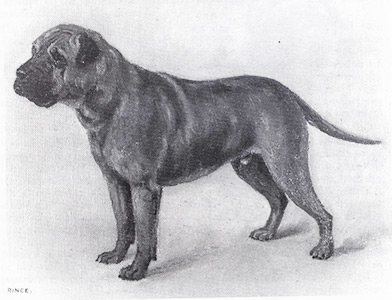
Ch Tiger Prince - 1st Bull-Mastiff Dog Challenge Certificate winner
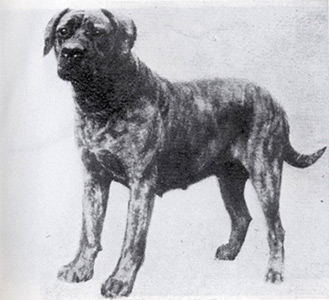
Ch Farcroft Silvo - 1st Bull-Mastiff Bitch Challenge Certificate winner and the first Bull-Mastiff Champion
The versitle dog in the field circa 1930s
"In the 1930s it was written by Author Arthur Craven that it might be said that the Bull-Mastiff is an animal that can see in the dark, and one that possesses a wonderful ear; in fact, no animal excels him on these points, and although he is termed a non-sporting dog, he has on occasions been trained to retrieve, and has carried out these duties in an efficient manner. I do not, of course, claim him to be a gun-dog in the strict sense of the word—far from it; nevertheless he has in the past been used by many owners for work in the field, and has put up a performance that belies his appearance, proving himself to have a soft mouth and to be an intelligent creature.
The breed, of course, was never intended for work in the field, and it would indeed be a bold person who would claim that they could equal at this task those animals that have been specially bred and trained for that purpose. Still, facts are stubborn things, and if the Bull-Mastiff has been used by some owners to do the work of a Retriever, it goes to prove that he is an animal easily trained, and capable of undertaking many duties.
Bull-Mastiffs are to-day mainly used as guards and companions, in addition to assisting the police, and for the latter requirements, as well as the former, they fill their position in an admirable manner, for, apart from attacking, they are splendid animals at tracking and have an excellent nose. Thus we find many of these dogs being used by officers of the force, for to those who are on night patrol in the lonely districts these animals are invaluable, as on the trail they are steady; hence many offenders owe their capture to the fact that their presence has been detected by these dogs, and they have been held until they have been arrested. As a police dog, I doubt if the Bull-Mastiff can be equalled; certainly at this work no breed can excel him. .Arthur Craven - Circa 1930s
A Popular Companion
Over the years the Bullmastiff became a popular companion and protector of his home and family, from 1925 UK Kennel Club litter registration numbers increased most years reaching a peak during 1997 & 1998. The fawn and red coloured varieties, with a black mask, seem to be the preferred colours and to this day are more numerous, although in recent years the brindle has made a comeback.
From its carefully selected ancestors, this purpose bred dog evolved into a robust, fearless, beautifully proportioned, imposing-looking animal, taking on the size and sheer pugnacity of appearance of the beautifully natured Mastiff, with the recognised courage and proven endurance of the renowned Bulldog of yesteryear.
These two famous breeds gave the Bullmastiff some important qualities, which are ideal in combination for a companion & protector:
- Superb temperament - even tempered, level headed, noble and never excitable
- Silent, dependable, almost arrogant bearing
- An inherent ability to assess the situation and more importantly, if trouble arises, the instinct to pin the quarry rather than to bite.
The confrontational expression on his black masked face and his impressive, almost regally impassive composure would be a commanding figure for any wrongdoer to confront, he really does look the part and doesn’t usually have to prove his abilities to any intruder or potential attacker his mere presence is enough to either freeze them to the spot or send them running off in the opposite direction!
Today's Bullmastiff
Handling & Training
True to his original job, the Bullmastiff makes an ideal companion - undemanding, affectionate and loyal to his owner. He is normally a quiet and stable dog, and is well suited to a family life. Socialization from an early age is of the utmost importance to prevent him from becoming over protective of his owners and his home.
Care should be taken when handling this breed, it is a large sturdy dog and it should be remembered that an adult dog needs a strong arm to hold him if he decides to go in the opposite direction!
Training classes for basic obedience and socialization are advised for all dogs and the training should be kind but firm and should be practiced from puppy into adulthood, no dog should be treated or trained with man-handling or rough treatment and Bullmastiffs do not respond to this type of training.
People, Dogs & Other Animals
Although friendly towards people, care should be taken when mixing with strange dogs to avoid any confrontation. The Bullmastiff will rarely seek trouble with other dogs, but he may not turn his back on it if confronted.
With careful introductions Bullmastiffs will normally adapt well to other pets or animals in and around the home if they are brought up with them, but like with all dogs all interactions should be supervised. Dog to dog aggression can be caused by a lack of socialization as a puppy, although this is not always the case. Generally and especially when they reach sexual maturity, Bullmastiff males may not get along with other males and bitches may not always be tolerant of either sex. There are always exceptions but it is less likely that two same sex Bullmastiffs will get on with each other.
Breeders - Temperament, Health, Soundness & Type
It is the duty of today's breeders to only breed from the best to maintain a high standard, and make improvements in the breed. A good temperament must be one of the first considerations when planning a mating - people do not want to be buying a liability. Soundness health and good type are essential and the Bullmastiffs bred from should be as near to the ideal as laid down by the Breed Standard.
High Spirited & Alert or Strong Willed & Stubborn?
Despite his appearance and size the Bullmastiff is high spirited and alert. Capable of quite an astounding turn of speed, he is extremely strong and although large he can be very agile and is essentially an active dog. They are friendly and outgoing and they all have their own different personalities, they can appear to be strong willed and stubborn at times too.
The Bullmastiff has excellent self-assurance and this has to be utilized to good effect by fair, firm and consistent training so that he becomes equally proud of his self-restraint.
Don't expect subservience from this breed and don’t be fooled by the snoozing dog either. Bullmastiffs can have a strong sense of smell and very acute hearing. He or she can in a split second go from apparently fast asleep, relaxed and flat out and only lifting one eyelid up to watch you walk by after stepping over him in the doorway to be standing next to you as you open the fridge door or snap a biscuit in half to dunk into your cup of tea.
With a twitch of the nose and a tilt of an ear they can be “on duty” standing proudly as if they own the ground they are standing on, looking any suspicious visitor in the eye as an equal and yielding to no one until their master says otherwise.
He may appear to be slower to train compared to other breeds, he usually needs a reason for doing things and during training, obeying a command may come a little slower than expected whilst he thinks about it, but with patience and consistency once trained correctly they never forget what they have been taught to do.
At Home, Children & Play
The Bullmastiff likes to play but don’t expect him to chase a ball for hours on end; that is not in his job description! He may fetch it a few times but the next time you can go and get it yourself!
At home he loves his family, is extremely fond of human companionship and in general they are particularly fond and tolerant of children, but it is important that children should be taught to treat all dogs and other animals with kindness and respect. Play and any interaction with a child should always be supervised by an adult, a Bullmastiff can be clumsy, and can easily cause an accidental injury to a child by simply quickly turning around and knocking them over. A child should never be allowed to walk a Bullmastiff on their own without an adult present and as with all dogs they should never be left alone with the dog.
The Bullmastiff prefers to be in the heart of the home rather than sitting on his own in a kennel or in another room, they are not content in being left alone for long periods of time, boredom and loneliness can become a problem and are a major cause of chewing and other behavioural problems in the home.
Slobber & Drool
Due to them being a "soft mouthed” breed they can and do produce slobber - some dogs more than others. Slobber can be difficult to remove from clothing - especially after a drink or when food is around. A quick shake of the head can leave anyone and anything spotted with slobber which can also end up sticking to the walls and decoratively dangling from the ceiling. If you are in any way meticulously house proud or fashion conscious, this is probably not be the best breed for you!
Loyal Companion
A well trained Bullmastiff appears to have wonderful powers of discrimination and at home or away they are generally protective of their master and their surroundings. They will not interfere with your invited friends and any welcomed visitors, they will be very pleased to meet them, but they will treat unexpected visitors or approaching people with suspicion until told otherwise.
Give him a loving and secure environment and train him well with consistent firm but fair handling and you will gain the confidence of a Bullmastiff, together with his respect, and you have the best loyal companion of all dogs.








